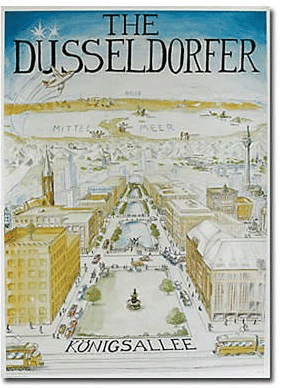
Follow us and get access to the history of Düsseldorf on alternativ pathes...
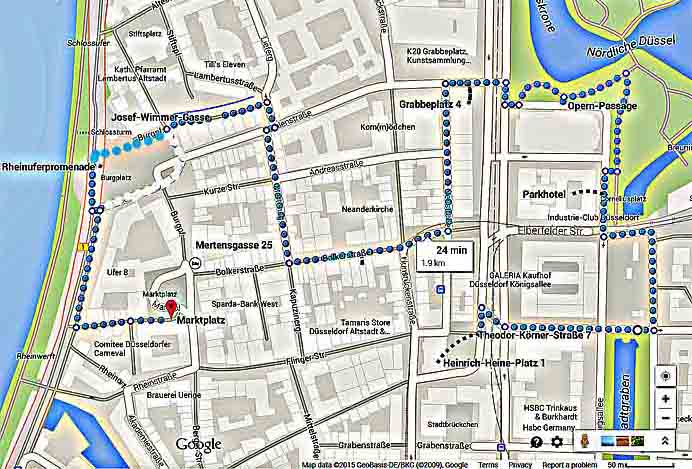
We start at the Carsch-House, cross the Heinrich Heine-Allee and move via
Theodor-Körner-Str. towards Königsallee / Hofgarten.
The magnificent Art Nouveau building on the Königsallee No.1 was opened in 1907 as a department store TIETZ in order to initiate a new trend. Shopping should not consist solely of the procurement of vital goods, but should be upgraded to an event tour of adventure and discovery.
In modern times, other trendsetters follow, such as SCHADOW-ARKADEN, KÖ-GALLERY or SEVENS. But careful! These are no low-cost locations of cheap Johnny, but luxury boutiques to high society. The last strike by the name of KÖ-Bogen has pushed the discussion, how much luxury a solid city can absorb.
On the centre strip of the Königsallee you are looking at a ditch. The water of that ditch is feeded by the river Düssel, exactly by the two branches of the Düssel: the northern branch (where we are standing) and the southern branch (at the end of the horizon).
In former times this was a moat, which protected the city wall (on the right side). After the demolition of that wall after 1804 a grand boulevard came into being, once called Kastanienallee due to the chestnut trees.
In 1815 Dusseldorf gets under Prussian rule. In the revolutionary year of
1848 here the Prussian King was booed by an angry mob and supposed to be pelted with horse
shit. Later - after the failure of the revolution - the city leaders have
to do nothing more important than to ask in Berlin at the royal family for
forgiveness and - as restitution - to rename the Kastanienallee in
Königsallee (Kings Avenue). This is done in the year 1851.
Towards the end of the 19th century a stormy industrialization occurs. The number of inhabitants is increasing rapidly. In 1882 the 100,000 mark is exceeded. Dusseldorf becomes major city and develops to "desk of the Ruhr Area", where the steel barons of Rhine and Ruhr (eg Thyssen and Krupp) entertain there political liaison office.
In January 1932 there is a fateful meeting at the Park Hotel; in attendance the crème de la crème of West German bankers and industrial bosses. The theme of the conference: power and money; guest speaker a certain Adolf Hitler.
The news spread like wildfire and puts people on the move, many of them unemployed. And while at the Park Hotel the shutters rattle, chorus of voices chant on the street: "Down with the Nazis! Hitler, that's the war!" As long as the police makes "law and order" on a notorious model and locks a number of anti-fascists in the basement of the neighbouring opera.
Meanwhile Hitler explains his goals: He promises the illustrious audience the destruction of the trade unions and labour movement, increasing of arms expenditures and the conquest of new lands. No wonder that with such prospects the assembled bankers and industrialists get shiny eyes and are supporting the Nazi party from now on generous with money and make them socially acceptable. Because in the near future they will be awarded with generous contracts and can collect the rewards.
Another imperator, the French Emperor Napoleon, penetrated Dusseldorf in 1811 on the Kaiserstraße, named after the emperor and closing the Hofgarten to the north. Napoleon’s intention: to recruit soldiers for the invasion of Russia.
|
Düsseldorf, |
Here supposedly the famous saying should have fallen:
But in reality it is a legend, because the quote comes from a letter that a Secretary of Napoleon wrote with the meaning chaos and sloppiness ... as in Paris.
But anyway, Düsseldorf dominates the art of beautiful wording. Today we speak about “marketing”.
We walk through the Hofgarten, which is built in 1769 as the first German folk garden; a park, not - as usual - for the exclusive amusement of the nobility and his courtiers, but open to the citizens of this city.
The style is no longer - as in the Baroque - shaped by French influences, i.e. the subjugation of nature through the exact geometric alignment of the plants, in this way showing symbolically the absolute power of the reigning ruler.
For the mid-18th Century a countermovement is coming from England. The nature shall no longer be trimmed and enslaved, but left in a natural state. This includes undulating terrain, a bizarre system of watercourses and an intricate network of paths that pretend a large expansion.
At the Landskrone we cross again the Heinrich-Heine-Allee, towards the Altstadt.
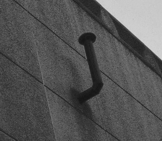 We
are now in the heart of the city of art. Left Kunsthalle, a hulking building from the sixties, with the outwardly projecting "stovepipe". Thus, the
famous art professor Joseph Beuys once wanted to bring fresh air into the established culture operation.
We
are now in the heart of the city of art. Left Kunsthalle, a hulking building from the sixties, with the outwardly projecting "stovepipe". Thus, the
famous art professor Joseph Beuys once wanted to bring fresh air into the established culture operation.
Not all artworks by Beuys have survived the ravages of time.
The famous "Fettecke" (fat corner) in the Kunstakademie was destroyed by a vigorous facility manager by mopping up.
The people of Düsseldorf chuckled when they heard it.
Less laughable, however, was the lengthy court battle that one of Beuys students waged against the State of North Rhine-Westphalia. Using the argument that the great master would have given him the "work" during his lifetime, the clever complainer snatched finally 40,000 Mark compensation.
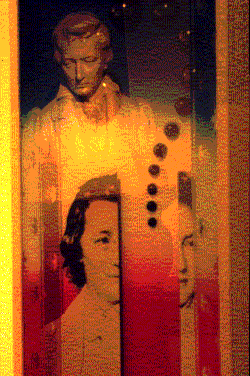 Foto: Ulrich Otte
www.duesseldorf.de/touristik/bildarchiv/
Foto: Ulrich Otte
www.duesseldorf.de/touristik/bildarchiv/
Following the Neustraße we reach the Bolkerstr.53 where a plaque proclaims: "Here Heinrich Heine was born on December 17, 1797"
Not quite true, because little Harry (that was his birth name), had seen the light of this world in a rear building.
In the last war bombs hit the home and the Nazis, who previously burned his books, eliminate the remains.
But Heinrich Heine, Düsseldorf's most famous son, is hated not only by the Nazis. Even bourgeois conservative circles have not forgiven him his loose vicious tongue with which he denounces especially dull nationalism and small-minded philistinism.
Since 1831 Heinrich Heine is forced to live in exile in Paris, as he is pursued warrant in Prussia and his works are prohibited. In "The Book Le Grand", he describes his childhood memories:
"The city of Dusseldorf is very nice and if you are in the distance and remembering it, it is a strange feeling. I was born there and it seems to me that I would have to go straight home. And when I say go home, I think the Bolkerstraße and the house in which I was born."
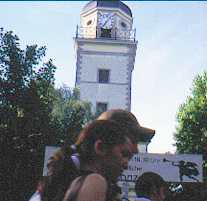 Continuing towards the town hall we pass the Neanderkirche, which is located hidden and inconspicuously in the backyard.
It is a Protestant church, which was built under the reign of the Great Elector Jan Wellem.
Continuing towards the town hall we pass the Neanderkirche, which is located hidden and inconspicuously in the backyard.
It is a Protestant church, which was built under the reign of the Great Elector Jan Wellem.
At this time a relatively liberal climate dominated in Dusseldorf. No one is brutally suppressed because of his religion. Protestants (and even Jews) are allowed to build houses of worship, but please something discreetly and in the background.
The name Neander goes back to the North German itinerant preacher John Neander, who founded a church in Dusseldorf and had occasionally to disappear into the underground in order to preach and sing untroubled. His preferred place were the limestone caves of the nearby Neandertal, hence the name.
And today the valley - on the basis of the bone finds of the year 1856 – is more famous than Dusseldorf, because the expression “Neanderthal-man", is known by every school child in the world.
At the Josef-Wimmer-Gasse the Düssel sees the light of day again and we discover a symbolic bronze sculpture by Bert Gerresheim. It is inaugurated in 1988 for the 700th anniversary of the city and shows - like an open book - scenes from the history of Düsseldorf.
In the focus the battle of Worringen which decided 1288 a certain Count Adolf V of Berg in alliance with Cologne citizens and exploited peasants. They defeated the Archbishop of Cologne and founded a base on the Rhine: the village at the Düssel, as a toll station and as a gateway to the big, wide world.
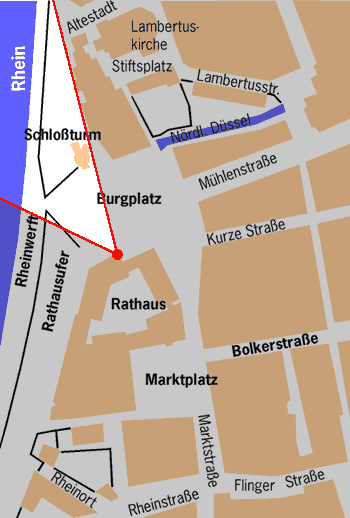
At the Burgplatz we look on the restored Schlossturm (castle tower) and the Oberkasseler Brücke (bridge);
click here, to get an actual view...
/live-bilder-aus-duesseldorf/
The tower is the only relic of the former Düsseldorf castle, which was destroyed by fire in 1872 and not rebuilt.
This beautiful place is for the Rhinelanders as important as the piazza for Italiens: that means centre of the city, if not centre of the world.
Here you can eat and drink to your heart's desire, discuss or sit with self-catering on the Spanish Steps and enjoy the sunset.
All these amusements are car and emission-free, thanks to the Rhine tunnel, relocating 1993 the traffic of a noisy city highway to the underground, a great moment of modern urban architecture.
Today, the Rhine promenade is one of the most popular promenades in Düsseldorf, which has given new impetus to the housing in the city.
In the northern background we look at the leaning tower of the ancient Lambertus Church. Numerous legends entangle this landmark of the city. Who is to blame for the misery: the revenge of the builder or even the mad strangle¬hold of the devil? No, simply the warped wooden beams of the roof, when they were renewed after the last fire.
Inside, as in most churches, there are many valuable things to visit.
These treasures are not always gained in an honest way, such as the bones of the city's patron, Saint Apollinarius.
At the end of the 14th century these were taken away by Duke William from brave monks in the area of Remagen.
This allowed Dusseldorf to become a popular place of pilgrimage. Hostels, restaurants and souvenir sellers make their profits and at peak times there are operating up to 20 altars in the church, where the pilgrims mass is celebrated.
Into town we look at a white building on the corner of Burgplatz / Marktstr. Here the world famous Düsseldorf collection of paintings of the Elector Jan Wellem was previously housed.
The person of Jan-Wellem embodies the heyday of Dusseldorf. Instead of waging war, he promotes the fine arts and develops Dusseldorf to a world-famous cultural centre. Sadly, the marriage remains childless with Anna Maria Luisa Medici. On the death of the Elector Dusseldorf falls to the Wittelsbach house, a southern German noble family and is governed in the future from Mannheim, and later from Munich.
In order to be appointed from Napoleon to Kings of Bavaria the Wittelsbacher sell off their Rhenish properties in January 1805 to the French Empire. But before - under cover of night - the paintings were taken away to Munich and can today be admired in the old Pinakothek.
Leftover are only 2 great daubs of Rubens that were so big that they could be poorly transported and today hang in the Museum of Art in Düsseldorf...
Museum Kunstpalast.
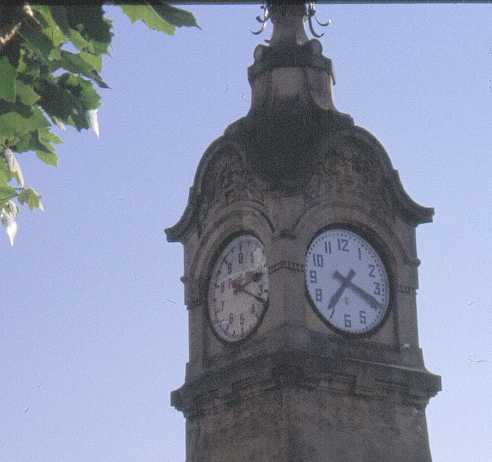
On the Rhine promenade we stroll a bit southwards until the water meter. Looks like a clock and is also one, but be careful. 7:30 - depending on the viewing angle - have two meanings: 7 hours and 30 minutes or 7 ½ meter above normal; the latter means the water level of the Rhine.
Up to 12 meters, it can rise so high is the wall. Only then the old town would be flooded. So far, however, that case never occurred, because in Cologne, the Rhine dams have only a maximum height of 11.50 m.
And before the wave can reach Dusseldorf, Cologne is used as a flood basin and the people of Düsseldorf are at the quay and agree to the carnival hit: "Do schwimmt ene Kölner"... (There swims a Colognien).
In the immediate vicinity of the Pegeluhr - at a distance of 300 meters - the southern and the northern branch of the Düssel flow into the Rhine.
Into town on the Zollstr. we see the historic restaurant EN DE CANON. Above the front door you can still see the old high-water marks from the time when the city was still unprotected from flooding. Here formerly it is said that the Elector Jan Wellem boozed with art friends and citizens of Düsseldorf.
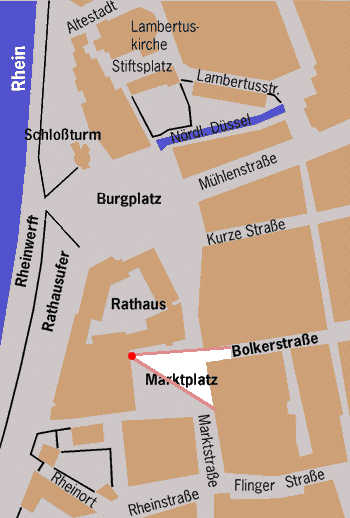 The
statue of Jan Wellem is located around the corner at the Düsseldorf marketplace.
In 1711 it is situated there and is now one of the most famous Baroque monuments
north of the Alps.
The
statue of Jan Wellem is located around the corner at the Düsseldorf marketplace.
In 1711 it is situated there and is now one of the most famous Baroque monuments
north of the Alps.
200 years ago, still no lock screen and no socket exists. The equestrian statue can be climbed by young people, such as the young Harry Heine, who later recalled in "Das Buch Le Grand" an episode from his childhood.
In 1806, he is sitting there with his comrades observing the entry of the French. The Düsseldorf councillors have attracted "new faces" and change with flying colours to the Napoleon Administration.
Nowadays, you can observe such events also from far away, via per webcam on the net... click here, to have an actual look.
An architectural jewel is also the Dusseldorf Town Hall, a baroque brick
building with Renaissance gables and octagonal stair tower. Note especially the
slight asymmetry of the gable arches, according to the motto: Nothing made by
man is perfect and plated perfectionism is the death of architecture and the end of humanity.
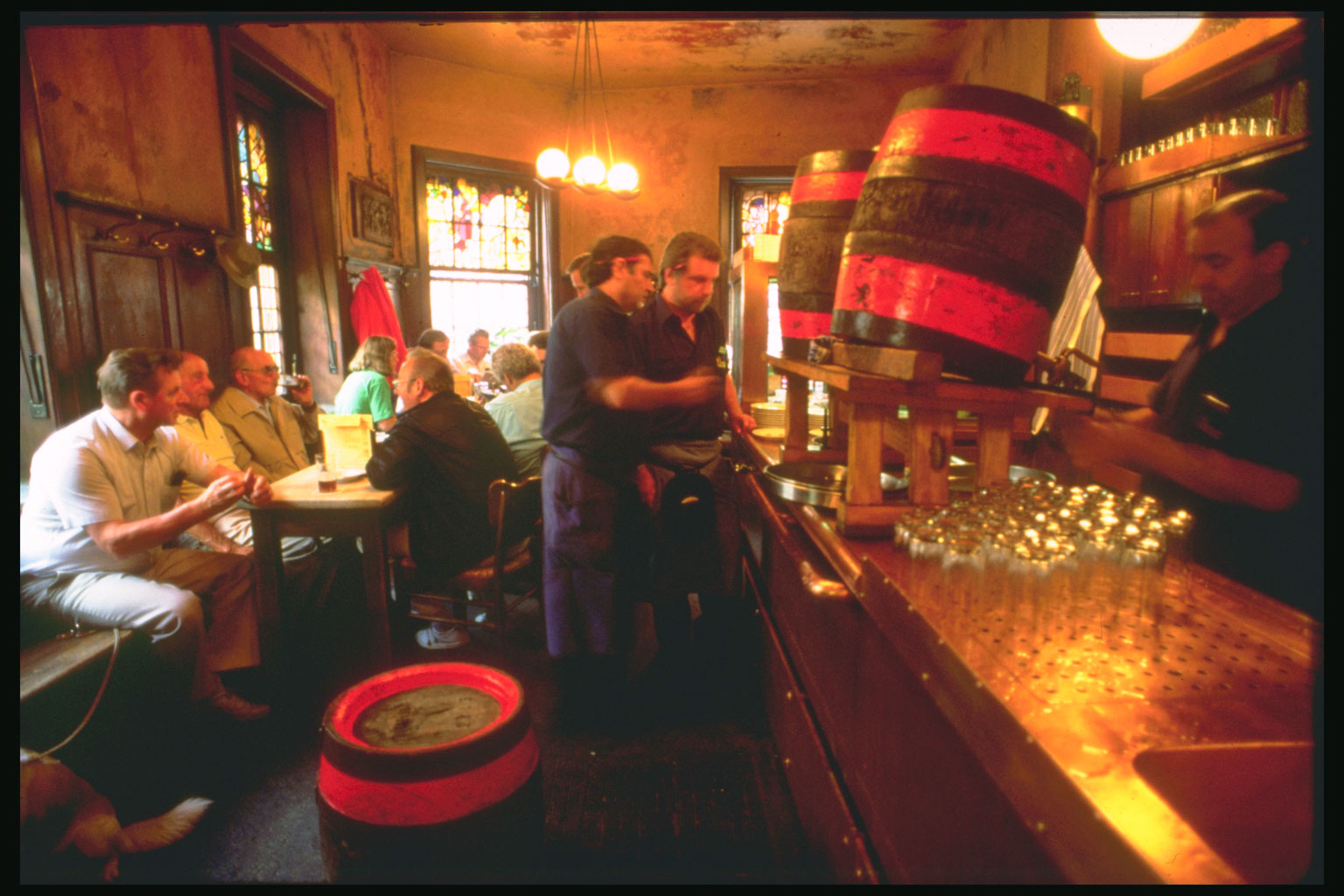
With this final word we end the cultural and historical part of our excursion and turn to gastronomic pleasures. Also on this area Dusseldorf has much to offer and problems arise only if we cannot decide at the abundance of alternatives.
Photo: Ulrich Otte... more photos
Official information and booking:
www.duesseldorf-tourismus.de